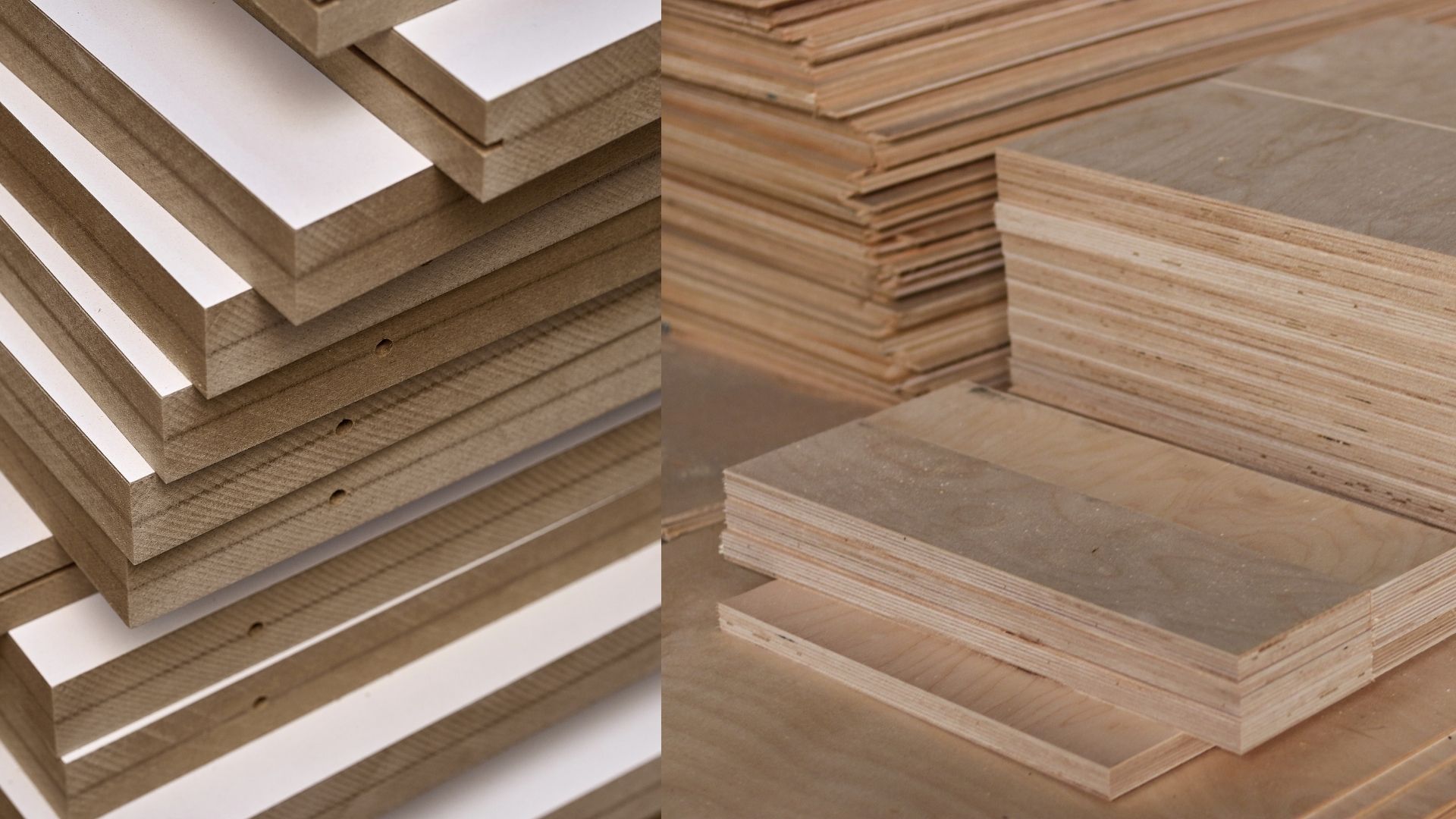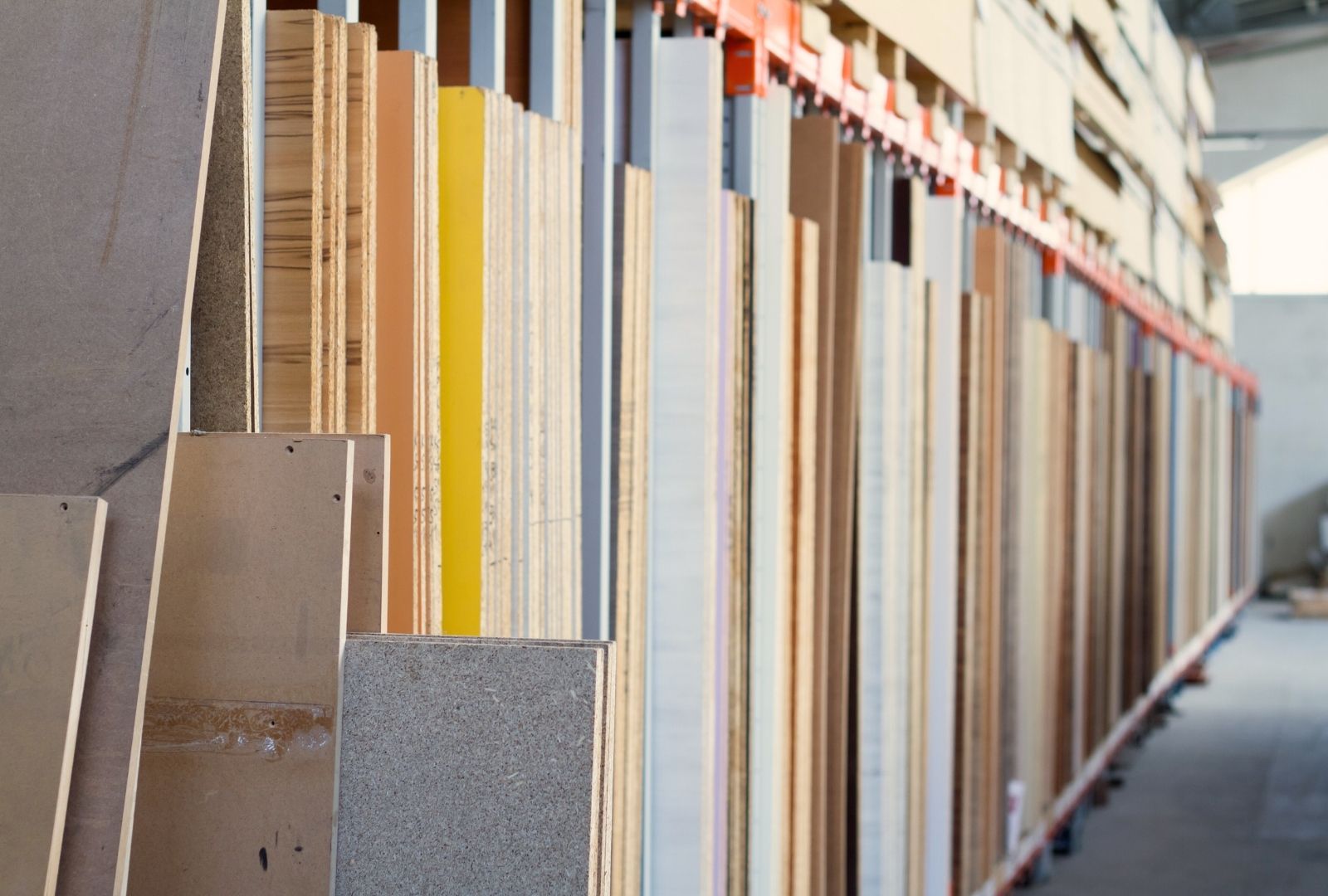Difference Between MDF vs Plywood: Pros and Cons

When it comes to furniture, shelving, or cabinetry, deciding between MDF and plywood can feel overwhelming. Both are popular engineered wood options, and while they share some similarities, the difference between MDF and plywood becomes clear once you look at strength, durability, moisture resistance, cost, and finish. Understanding the pros and cons of each helps you make a better choice for your project.
What is MDF (Medium-Density Fibreboard)?
Medium-density fibreboard is an engineered wood product created by compressing wood fibres with resin and wax. MDF is made using heat and pressure, which produces dense, uniform MDF panels with no natural defects. Since MDF is made from recycled wood, it’s often considered an eco-friendly wood product.
Because MDF is easier to cut than many other materials, it’s a popular option for mouldings, decorative edges, and medium-density fiberboard cabinets. A smooth surface means MDF can be used for painted finishes that look flawless. Designers often choose MDF board for modern interiors where clean edges and precise details matter.
Advantages of MDF
- Consistent material without knots or visible wood defects.
- MDF is ideal for detailed designs and painted finishes.
- Affordable and eco-friendly, since MDF helps reduce waste.
- MDF is generally cheaper than plywood, making it cost-effective.
- Available in various thicknesses, so it’s the best MDF option for versatile applications.
Drawbacks of MDF
- MDF can swell when exposed to moisture.
- It is not as strong as plywood.
- Heavier and harder to move compared to plywood.
What is Plywood?
Plywood is made from thin layers of wood veneer glued together. These layers of wood veneers overlap with alternating grain directions, creating a stable and durable material. Because of this, plywood is strong and suitable for structural work.
Plywood can be used for furniture, flooring, wall panels, and plywood cabinets. Many homeowners prefer the natural wood look since plywood retains the natural grain and often showcases visible wood grains or knots. High-quality plywood sheets and hardwood plywood also allow for premium finishes.
While plywood is generally more expensive than MDF, it offers better moisture resistance and durability. For long-lasting furniture, plywood is also a reliable material.
Advantages of Plywood
- Strength of plywood makes it excellent for structural applications.
- Plywood tends to resist moisture unlike MDF, which can swell.
- Natural beauty with a wood grain finish and solid wood appeal.
- Available in higher grades of plywood for premium design.
- Plywood holds screws and nails securely, great for strong joins.
Drawbacks of Plywood
- Plywood is more expensive
- Slightly harder to shape compared to MDF
MDF vs Plywood: Pros and Cons Compared
When comparing MDF with plywood, it’s helpful to look at each feature side by side:
- Composition: MDF is made using compressed fibres, while plywood comes from thin layers of wood veneer glued in alternating patterns.
- Surface: MDF allows a flawless wood veneer or painted finish thanks to its smooth surface. Plywood exhibits better natural character, with visible wood and a natural look of plywood.
- Strength: MDF is often stable for decorative projects, but plywood is typically stronger and better than MDF in load-bearing roles.
- Moisture Resistance: Although MDF can swell, plywood exhibits better performance in humid areas.
- Cost: MDF is generally cheaper, while plywood is generally more expensive.
- Workability: MDF is also easier for detail cuts since MDF is easy to cut, while plywood still requires careful handling.
- Durability: For longevity, plywood is a versatile material and is often better for cabinets exposed to stress.

Should you choose MDF or Plywood for Your Project?
Deciding between MDF and plywood depends on where and how the material will be used. Here are some key considerations:
- Cabinets: If you want a painted finish, go with MDF. For a natural wood finish, plywood or MDF may both work, but plywood offers cabinets a warm and authentic feel.
- Moisture-prone spaces: Use plywood in kitchens, bathrooms, or laundry rooms, since it’s better for your cabinets in these conditions.
- Furniture and shelving: Either MDF or plywood works, but joining plywood components offers more strength, while using MDF allows intricate details.
- Decorative finishes: MDF is best when you need clean edges, mouldings, or veneered panels that look like solid wood at a lower price.
When choosing between MDF and plywood, think about cost, aesthetics, and durability. If you want something sleek, MDF is typically the choice for cabinets with painted designs. If you want long-lasting structural support, high-quality plywood or plywood panels may be a better solution.
The Bottom Line
The MDF vs plywood debate doesn’t have a single winner, it all comes down to your project. MDF is strong enough for decorative uses, affordable, and eco-friendly, while plywood tends to last longer, handle moisture, and provide a natural wood look.
At Worldwide Timber Traders, you’ll find a wide selection of MDF panels and plywood sheets. Whether you’re deciding between MDF or plywood for cabinets, shelving, or structural work, our team can guide you to the better choice. Explore a wide range of plywood products and MDF panels to transform your interiors with modern or traditional designs. Contact Worldwide Timber Traders today for expert help in choosing between MDF and plywood for your next project
Related articles

Blog title heading will go here

Blog title heading will go here


